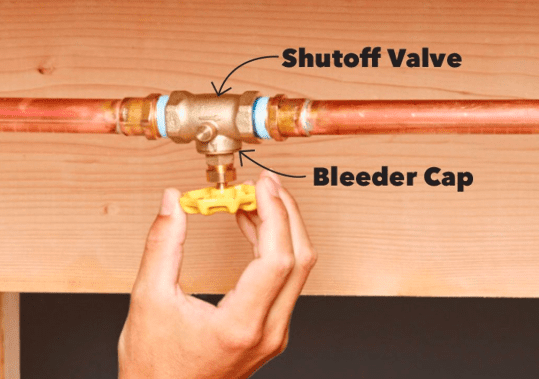Blog
Preventing Winter Water Leaks from the Hose Bib

If you asked most homeowners in Cincinnati, “what is a hose bib,” it’s a safe bet they wouldn’t know. This isn’t surprising as most people are unfamiliar with the technical names of components in their home’s plumbing system.
Many clients generally only learn about plumbing components after there’s a problem. Hose bibs are, unfortunately, susceptible to damage from the cold of winter. Luckily, this damage is perfectly preventable with a little knowledge and winterization preparation.
In this article, we’ll cover what hose bibs are and how to care for them to prevent water leaks.
What Is a Hose Bib?
If you are wondering what a hose bib is, take a look around your home’s exterior. You likely have one on the rear side of your home and maybe also one on the front.
So, what is a hose bib? The definition of a hose bib is an outdoor water tap on the exterior of a home. This spigot has a threaded spout that allows the homeowner to connect a garden hose for outdoor water use. A hose bib is also called a sill cock, hose spigot, outdoor spigot, hose bibb, or hose faucet.
How to Prevent Water Leaks from the Hose Bib
It’s important that you disconnect any attached hoses from the hose bib before cold weather hits. When a hose is attached, water does not drain out of the hose bib. The water inside swells when it freezes, leading to cracks. A cracked hose bib allows for continuous water leaks until the unit is replaced.

When you are finished with outdoor water use and turn the valve off, the hose bib is designed to drain out water from the exterior portion of the component. This is to protect itself against water freezing within the component. This causes damage to the hose bib and frozen pipes inside your home that supply the hose bib with water. A cracked hose bib must be replaced to prevent water leaks inside your home.
You can prevent hose bib water leaks and damage when you take the following steps before winter arrives:
- Find the hose bib’s shutoff valve inside your home’s basement, crawlspace, or utility closet.
- Adjust the shutoff valve to stop the supply of water to the hose bib.
- Detach the hose from the hose bib outside. Drain the water from your hose, and store it in a protected area until spring.
- After the hose is disconnected, turn the hose bib on and allow any water left inside to run out.
- Leave the hose bib on through the winter in case the shutoff valve leaks, allowing water into the hose bib’s supply line. This allows leaked water to escape rather than freeze within the pipe.
- Return to the shutoff valve location and identify the bleeder valve (it’s usually under the shutoff valve with a small metal cap). Place a bowl under the bleeder valve and remove its cap so excess water drains out.
- Put the cap back on the bleeder valve and retighten it.
- Repeat these steps for all hose bibs at your home.
What Happens if a Hose Bib Freezes?
Even if the plumbing appears fine all winter, some homeowners discover the problem in the spring when they use their outdoor hose for the first time. We’ve sent our plumbers to homes where someone used a powerwasher or left a hose running to fill a pool only to flood their crawlspace and house.
Water damage is no joke. It costs homeowners and insurance companies every year. Here are some eye-opening statistics in this infographic based on insurance industry information.
Courtesy of: Water Damage Defense
What Is a Frost-Free Hose Bib?
A frost-free hose bib, or winter hose bib, is a specially designed outdoor spigot that prevents freezing during the winter months. As freezing is quite common in the Cincinnati area, these hose bibs are handy. Frost-free hose bibs look just like regular hose bibs on the outside of your home, but the interior components are slightly different.
The frost-free hose bib’s interior piping is longer, with the bib shutoff valve located farther away from the exterior wall. The pipe also angles downward to allow for the easy draining in the event of water leaks. With the shutoff valve closer to the home’s center, the water stays warmer, so there is less risk of freezing. Most modern homes today use a frost-free hose bib.
Even with a frost-free hose bib, it is still important to prepare for winter. Turn off your bib’s shut-off valve and let the water drain. It is vital to disconnect and store all hoses for the winter.
Want to Install Winter Hose Bibs in Cincinnati?
For maintenance, repair, and replacement of hose bibs in Cincinnati or Northern Kentucky, Apollo Home has the solutions you need.
Contact us today to schedule service for your hose bib or to discuss an upgrade to a frost-free model. Need a licensed electrician or heating and cooling help? We can take care of that too!



